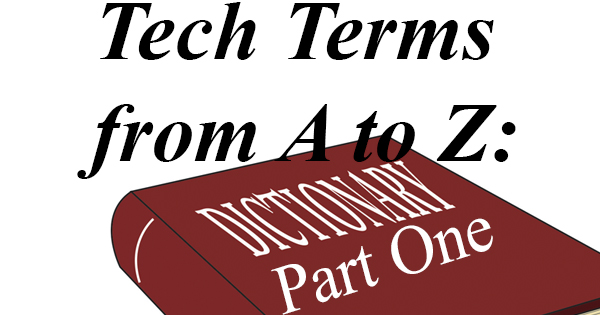 In my business, I come across all types. Some people don’t know anything about technology, and make that obvious when they begin describing a problem that they’re experiencing. After almost thirteen years of doing this gig, I can usually figure out what they’re driving at, but it’s often difficult to visualize from a phone call. My favorite group to work with is the type of person who thinks they know what they’re talking about, but use the wrong terminology. Referring to a desktop tower and calling it a CPU is not correct. I don’t laugh at these people…at least not on the outside. Bring me your clueless, your terrified, any day of the week! I finally decided it would be helpful to begin a new Finish Line Blog series documenting common tech terms to make all of our lives a little easier. Since we’re talking about twenty six letters, this will be a multi-part series. Let’s begin part one now.
In my business, I come across all types. Some people don’t know anything about technology, and make that obvious when they begin describing a problem that they’re experiencing. After almost thirteen years of doing this gig, I can usually figure out what they’re driving at, but it’s often difficult to visualize from a phone call. My favorite group to work with is the type of person who thinks they know what they’re talking about, but use the wrong terminology. Referring to a desktop tower and calling it a CPU is not correct. I don’t laugh at these people…at least not on the outside. Bring me your clueless, your terrified, any day of the week! I finally decided it would be helpful to begin a new Finish Line Blog series documenting common tech terms to make all of our lives a little easier. Since we’re talking about twenty six letters, this will be a multi-part series. Let’s begin part one now.
Ok, so maybe I lied. It’s not technically an “A to Z” series because there are a few numbers included. 3G seems like a good place to start. If you have a smartphone with a data plan, you might see “3G” at the top of your phone next to your provider. “3G” simply means you’re using the third generation of cellular data speed. “4G” is the latest standard. This is the fourth generation of data transfer. Not surprisingly, 4G is faster than 3G. When you’re at home or at work though, make sure your phone is connected to Wi-Fi.
“Airplane Mode” is an option that many phones come equipped with. When a user switches their device to Airplane Mode, the wireless function of the phone is disabled, allowing you to use it while in-flight. Data and calling/texting is stopped. An “app” is short for application. An application is essentially a program that can be run on a device. The “App Store” is specific to Apple (iOS) devices. If you own an iPhone or iPad, this is where you’d go to download and/or purchase new apps.
A “band” is a range of wireless radio frequencies. If you’ve seen dual-band wireless routers, that means that that particular router can broadcast both modern bands: 2.4 GHz and 5 GHz channels. “Bandwidth” refers to how much information can be transmitted over a connection. Bandwidth is often expressed by megabits per second, and when you’re shopping an Internet connection from an Internet Service Provider (ISP), you’re selecting a package based on how much bandwidth you’ll be getting, for example, 100 megabits per second (Mbps). “Blu-Ray” is an optical disc storage system that’s been designed to store approximately five times as much information as a standard DVD (25 GB). Blu-Ray discs offer high definition video display. “Bluetooth” is a technology developed to connect devices (like smartphones and laptops) with other devices from close proximity. Examples of Bluetooth devices include hands-free devices and audio speakers. For more information about the specifics of Bluetooth, read “Bluetooth Shall Set You Free”. A “byte” is a single unit of digital information.
“Cache” is an area of memory that stores copies of information that may need to be accessed again by a device in the near future. “Captcha” stands for Completely Automated Public Tuning Test, and was designed to tell computers and humans apart. Have you ever had to type a series of numbers and letters to verify that you’re a human before signing in to a website? If so, you’ve completed a Captcha. A “carrier” is a company that provides wireless or data communications. Has “Carrier Update Available” ever popped up on your iPhone? It does on mine all the time. That means that Verizon (in my case) has come out with an update for their service. “CD” is short for “compact disc”. A CD will hold 700 MB of data. “Clock speed” is a the rate (measured in GHz) at which a CPU operates. The faster the clock speed, the faster the computer will perform. What is the CPU? “CPU” stands for “central processing unit”. It is the brain of the device.
“DCIM” stands for “digital camera images”. If you’ve ever plugged your phone into a computer and found pictures stored in a folder labeled DCIM, now you know why. A “disk image” is a single file that contains all of the files contained on a DVD. To “download” is to copy files from one computer to another. “DSL” stands for “digital subscriber line”. DSL is a type of Internet connection requiring a phone line to be present to transmit data. “DVD,” or digital video disc, is an optical disc that holds 4.7GB of data.
We’re just scratching the surface. Digest these first terms, and we’ll hit you with the next round next week!
